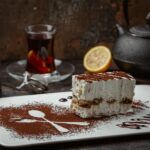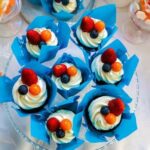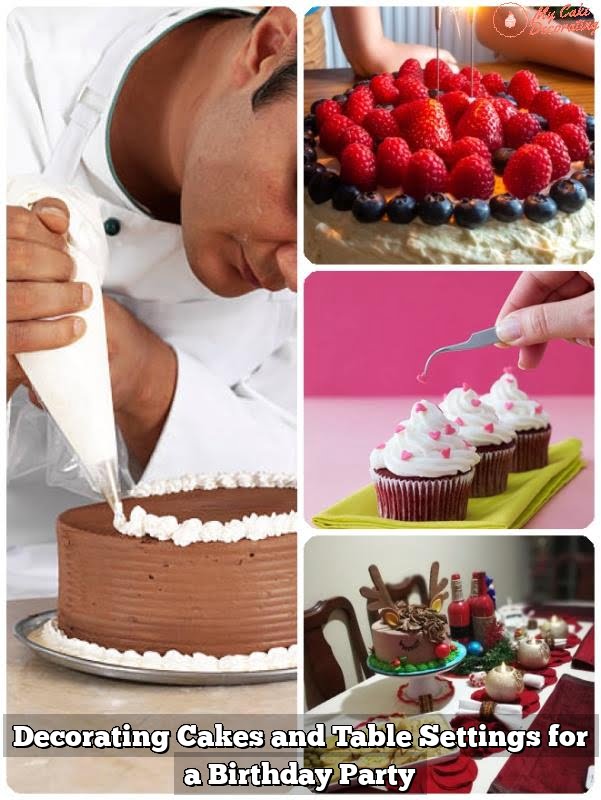Cake decorating is an art that requires precision and creativity. Whether you are a professional baker or an amateur enthusiast, having the right tools can make a world of difference in the final outcome of your cakes. One such tool that is essential for every cake decorator is a turning table.
A turning table, also known as a revolving cake stand, is a simple yet invaluable device that helps bakers achieve professional results in their cake decorating endeavors. This rotating platform allows you to effortlessly turn your cake while working on it, giving you easy access to all sides and angles. It eliminates the need to constantly walk around the cake, making the decorating process much more efficient and convenient.
In addition to its practicality, a turning table also enhances the precision of your designs. The smooth rotation enables you to work with steady hands, ensuring clean lines and smooth icing application. It also makes it easier to pipe intricate details or create delicate decorations without any awkward movements.
In this article, we will delve deeper into the importance of a turning table for cake decorating and explore its numerous benefits. We will discuss how to choose the perfect turning table for your specific needs by considering various factors and important features. Furthermore, we will provide you with an in-depth review of the top 5 turning tables available on the market, along with a detailed comparison.
Stay tuned as we guide you through step-by-step instructions on how to use a turning table effectively for achieving professional results in your cake decorating projects. We will also share some insider tips and tricks to enhance your skills and creativity when using this indispensable tool.
So if you are ready to take your cake decorating game up several notches, keep reading this comprehensive guide on turning tables for cake decorating.
Exploring the Benefits of Using a Turning Table for Cake Decorating
Using a turning table for cake decorating can greatly enhance precision and efficiency in your cake decorating projects. Whether you are a professional baker or an enthusiastic home baker, a turning table is an invaluable tool that can take your cake decorating skills to the next level.
One of the key benefits of using a turning table is that it allows for smooth, consistent rotations of the cake. This rotation makes it easier to access all sides of the cake and ensures even frosting and decorations. Instead of having to walk around the cake, a turning table brings the cake to you, allowing you to work comfortably from all angles.
Another advantage of using a turning table is the ability to achieve precise designs and decorations on your cakes. With the steady rotation provided by the turning table, you can pipe buttercream or create intricate designs with greater control and accuracy. This precision enables you to create perfectly straight lines, smooth edges, and evenly spaced decorations.
Furthermore, using a turning table can significantly improve efficiency in your cake decorating process. The continuous rotation eliminates the need to constantly reposition yourself or move around the cake while working on it. You can complete tasks more quickly and efficiently as you have easy access to every part of the cake without interruption.
How to Choose the Perfect Turning Table for Cake Decorating
Choosing the perfect turning table for cake decorating is essential for achieving professional results. With so many options available on the market, it can be overwhelming to determine which one is right for you. In this section, we will discuss the factors to consider and important features to look for when selecting a turning table for cake decorating.
Factors to Consider
When choosing a turning table, there are several factors that you should take into consideration. Firstly, think about the size of cakes you typically work with. If you mainly decorate small cakes or cupcakes, a smaller turning table may suffice. However, if you often work with larger tiered cakes, you will need a larger table that can accommodate their size and weight.
The stability of the turning table is another crucial aspect to consider. Look for a model that has a sturdy base and non-slip surface to ensure that your cakes remain securely in place while decorating. Additionally, check if the table has height-adjustable features as this can greatly improve your comfort and accessibility during the decorating process.
Important Features
There are several important features that should be present in an ideal turning table for cake decorating. One such feature is a smooth rotation mechanism. You want a table that rotates smoothly and quietly without any jerky movements or wobbling.
Another important feature to look for is an icing comb attachment or edge scraper guides. These attachments help create clean and consistent designs by allowing you to run a spatula or comb along the sides of the cake while it rotates.
Additionally, a locking mechanism is useful to have as it allows you to lock the table in place when necessary, especially when working on intricate details or delicate decorations.
By considering these factors and looking out for these important features, you can choose the perfect turning table for cake decorating that suits your specific needs and preferences. A well-chosen turning table will enhance your precision and efficiency while creating beautiful and professional cakes.
Top 5 Turning Tables for Cake Decorating
Turning Table A: Perfect Balance of Functionality and Affordability
The first turning table on our list is Turning Table A. This turning table provides the perfect balance between functionality and affordability, making it a great option for both beginner and experienced cake decorators. Its smooth rotation mechanism ensures precise and consistent turning, allowing you to decorate your cakes with ease.
One of the standout features of Turning Table A is its sturdy construction. Made from high-quality materials, this turning table is built to last. It can support heavy cakes without wobbling or slipping, providing you with a stable platform to work on. Additionally, it has a non-slip base that prevents it from moving around while you’re decorating.
Turning Table B: Versatile and Adjustable for Customized Cake Decorating
If you’re someone who loves experimenting with different cake designs and techniques, Turning Table B is the perfect option for you. This versatile turning table offers adjustable height and tilt features, allowing you to customize your cake decorating experience according to your needs.
Turning Table B also comes with a set of interchangeable platforms that cater to different cake sizes and shapes. Whether you’re decorating a small round cake or a multi-tiered masterpiece, this turning table has got you covered. Its smooth rotation combined with its adjustable features make it easy for you to reach all angles of your cake without straining or stretching.
Turning Table C: Professional-Grade Performance for Expert Cake Decorators
For those professionals looking for top-notch performance in their turning table, look no further than Turning Table C. Designed specifically for expert cake decorators, this turning table offers unparalleled precision and control during the decoration process.
What sets Turning Table C apart is its advanced motorized rotation system. With just a touch of a button, this turning table smoothly rotates your cakes at the desired speed, making it ideal for intricate designs that require a steady hand. It also has a built-in timer function, allowing you to keep track of your decorating time and ensure consistent results.
Step-by-Step Guide
Using a turning table for cake decorating can greatly enhance the precision and efficiency of your cake designs, allowing you to achieve professional results. Whether you are a beginner or an experienced baker, following a step-by-step guide can help you make the most out of your turning table and elevate your cake decorating game.
Step 1: Assemble and Prepare Your Turning Table
Before you begin using your turning table, make sure it is properly assembled and prepared. Most turning tables come with detachable parts that need to be put together. Follow the manufacturer’s instructions to ensure you have set it up correctly. Once assembled, clean and dry the surface of the table so that it is free from any residue or crumbs.
Step 2: Secure Your Cake on the Turning Table
Place your cake on the turning table and secure it in place. You can use frosting or a small amount of buttercream to adhere the cake board to the surface of the turning table. This will prevent any movement while you decorate.
Step 3: Smooth Out Frosting and Add Layers
Start by smoothing out the frosting on the sides and top of your cake using an offset spatula or a bench scraper. Next, add layers of frosting between each cake layer, spreading it evenly with a spatula or icing smoother as you go. Make sure each layer is level before moving on.
Step 4: Decorate with Precision
Once your cake is ready for decoration, the turning table will allow you to spin it smoothly as you work, providing better access to all sides of the cake. Whether piping intricate designs, applying fondant accents, or creating smooth buttercream finishes, being able to rotate your cake ensures even coverage and enhanced precision.
Step 5: Add Final Touches
As you approach the final stages of decorating your cake, continue using the turning table to add any final touches such as adding edible decorations like flowers or writing messages with icing. The ability to turn the cake easily on the table allows for smooth and consistent lines.
By following this step-by-step guide, you can unlock the full potential of your turning table for cake decorating. Remember to practice and experiment with different techniques to develop your own unique style and achieve professional results every time.
Insider Tips and Tricks for Utilizing a Turning Table for Cake Decorating
When it comes to cake decorating, using a turning table can greatly enhance your skills and creativity. The rotating feature of the turning table allows you to have better control over your cake, making it easier to achieve smooth and even frosting. In this section, we will explore some insider tips and tricks on how to make the most out of using a turning table for cake decorating.
One important tip is to start with a well-leveled cake. Uneven cakes can be difficult to work with on a turning table, so it’s crucial to take the time to level your cake layers before placing them on the turning table. This will ensure that your cake spins evenly while you decorate.
Another helpful trick is to use an offset spatula when frosting your cake on a turning table. The angled blade of an offset spatula allows you to easily apply and spread frosting while the cake rotates. This not only helps achieve smoother results but also minimizes the risk of accidentally touching the cake with your hands.
Additionally, experimenting with different piping techniques can elevate your cake designs when utilizing a turning table. From basic rosettes to intricate lace designs, the rotating motion of the turning table allows for more precise control as you pipe decorations onto your cakes. Don’t be afraid to try new techniques or mix different piping styles together – this can result in unique and impressive designs.
Lastly, practice makes perfect. The more you use a turning table for cake decorating, the better you’ll become at controlling its rotation and executing various techniques. Take advantage of online tutorials or attend workshops that focus on using a turning table effectively. Practice different methods of spinning the cake and discover what works best for you in terms of achieving steady rotations.
By following these insider tips and tricks, you can enhance your skills and creativity when utilizing a turning table for cake decorating. Remember to start with a well-leveled cake, use an offset spatula for frosting, experiment with piping techniques, and most importantly, practice frequently. With dedication and practice, you’ll be able to create stunning and professional-looking cakes using a turning table.
Common Mistakes to Avoid While Using a Turning Table for Cake Decorating
Mistakes happen, but when it comes to cake decorating, they can be particularly frustrating. Fortunately, many common mistakes can be easily avoided when using a turning table for cake decorating. By being aware of these potential pitfalls and implementing simple solutions, you can troubleshoot any issues that may arise and ensure a smooth and successful decorating process.
One common mistake to avoid is applying too much pressure while rotating the turning table. It’s important to remember that the turning table is designed to provide a smooth and steady rotation, so excessive force or pressure can disrupt the balance and cause the cake to shift or even slide off. To prevent this from happening, use gentle and consistent pressure when rotating the table, allowing the cake to spin freely without any unnecessary disturbances.
Another mistake to watch out for is neglecting proper leveling of the cake layers before placing them on the turning table. Uneven or tilted layers can create stability issues as you decorate, resulting in an imbalanced cake design. Before starting your decoration process, make sure each layer is leveled properly using a cake leveler or a long serrated knife. This will ensure that your cakes are stacked securely and prevent any wobbling or collapsing during the decorating process.
Additionally, it’s essential to avoid rushing through the decorating process on a turning table. Cake decorating requires patience and attention to detail, so take your time and work at a steady pace. Trying to rush through the process can lead to messy designs, uneven icing application, or other mistakes that could impact both the appearance and taste of your finished product.
| Common Mistake | Solution |
|---|---|
| Applying too much pressure while rotating | Use gentle and consistent pressure |
| Not leveling the cake layers properly | Ensure each layer is properly leveled before decorating |
| Rushing through the decorating process | Take your time and work at a steady pace |
Creative Ideas and Inspiration
A turning table for cake decorating is not only a practical tool that enhances precision and efficiency, but it also opens up a world of creative possibilities. With the ability to smoothly rotate your cake while working on it, you can achieve stunning designs and unique decorations that would otherwise be difficult or even impossible. In this section, we will explore some creative ideas and provide inspiration for showcasing the incredible designs that can be achieved with a turning table.
One popular technique made possible by a turning table is the creation of perfectly straight, smooth sides on your cake. With the ability to rotate the cake as you smooth out the buttercream or fondant, you can achieve seamless edges and flawless finishes. This creates an elegant canvas for further decoration and allows you to create clean lines and sharp angles in your designs.
Another exciting design possibility with a turning table is the creation of intricate patterns and textures. By using different piping tips or spatulas, you can create beautiful patterns such as rosettes, shells, ruffles, or even lace-like details on your cake. The rotation provided by the turning table allows for consistent spacing and evenness in your designs, resulting in a professional-looking finish.
Furthermore, a turning table enables effortless multi-dimensional designs such as ombre effects or gradient colors. By rotating the cake while applying different shades of icing or fondant, you can seamlessly blend colors together to create visually stunning effects. This technique is particularly effective when creating watercolor-inspired cakes or ombré floral designs.
Frequently Asked Questions (FAQs) about Turning Tables for Cake Decorating
As cake decorating with turning tables becomes more popular, it’s natural to have questions about this handy tool. In this section, we will answer some frequently asked questions (FAQs) about turning tables for cake decorating, providing expert answers and clarifications.
- Q: What is a turning table for cake decorating?
- A: A turning table, also known as a cake turntable or rotating cake stand, is a revolving platform that allows decorators to easily rotate the cake while working on it. It typically consists of a base and a flat surface where the cake sits. By spinning the table, decorators can access all sides of the cake without having to manually move it.
- Q: Why should I use a turning table for cake decorating?
- A: Using a turning table offers several benefits. Firstly, it enhances precision in decoration by allowing decorators to work on every angle of the cake effortlessly. This ensures even icing and smooth finishes.
Secondly, it improves efficiency as decorators can quickly spin the table to access different areas instead of constantly readjusting their position or moving the cake itself. Lastly, it reduces strain on the decorator’s wrist and hand since they can simply rotate the table instead of constantly twisting their arm. - Q: How do I choose the perfect turning table for cake decorating?
- A: When selecting a turning table, consider factors such as stability, size, material, and features. Look for a stable base that won’t wobble while you work. The size should accommodate your largest cakes comfortably without any overhang or balance issues.
As for materials, opt for food-grade plastic or stainless steel for easy cleaning and durability. Lastly, look for additional features like non-slip surfaces or locking mechanisms to provide extra stability during intricate decorating tasks.
By addressing these common FAQs about turning tables for cake decorating, beginners and experienced decorators alike can confidently embrace this tool in their creative process.
Conclusion
In conclusion, investing in the right turning table for cake decorating can truly elevate your game and take your creations to a whole new level. The benefits of using a turning table, such as enhanced precision and efficiency, are undeniable. With the ability to easily rotate your cake while decorating, you can achieve professional results with ease.
Choosing the perfect turning table is crucial for achieving optimal results. Factors such as size, stability, and rotation capability should be taken into consideration. It’s also important to look out for features such as non-slip surfaces and adjustable heights to ensure maximum control over your decorating process.
With our detailed review and comparison of the top 5 turning tables for cake decorating, you’ll have all the information you need to make an informed decision. Whether you’re a beginner or an experienced decorator, there’s a turning table out there that suits your needs.
Utilizing insider tips and tricks will help you further enhance your skills and creativity with a turning table. From creating intricate designs to achieving smooth finishes, these techniques will take your cakes from ordinary to extraordinary.
Lastly, it’s crucial to be aware of common mistakes that can occur while using a turning table. By troubleshooting these issues and finding solutions, you’ll be able to avoid any setbacks in your decorating journey.
Now that you have all the tools and knowledge at hand, it’s time to let your creativity shine. The possibilities are endless when it comes to showcasing unique designs achievable with a turning table. Get inspired by different patterns and textures that can be easily achieved through this versatile tool.
So don’t hesitate – elevate your cake decorating game by choosing the right turning table today. With practice and dedication, you’ll become a master at creating beautifully decorated cakes that are sure to impress any audience.
Frequently Asked Questions
What can I use instead of a turning table?
Instead of a turning table, there are various alternatives that can be used for cake decoration. One option is to use a lazy Susan, which is a rotating disc usually found in kitchens that allows you to easily access different items placed on it. Another alternative is using a cake stand with a rotating top.
This allows you to manually rotate the cake as needed while decorating. Additionally, some decorators prefer using a sturdy plate or cardboard base placed on top of an overturned bowl or container, and then rotating the cake by hand. Ultimately, the choice of what to use instead of a turning table depends on personal preference and what tools are readily available in your kitchen.
Which turntable is best for cake?
When choosing the best turntable for cakes, it’s important to consider several factors. The most ideal turntable for cake decoration is one that rotates smoothly and consistently without any wobbling or jerking motions. It should have a non-slip surface or grip to prevent the cake from moving around during decorating.
Some turntables also offer adjustable heights, allowing you to work comfortably at different levels or angles. Additionally, opt for one that is sturdy and durable enough to support the weight of your cakes. There are many well-regarded brands available in the market specifically designed for cake decorating purposes, so it’s worth reading reviews and considering recommendations from experienced bakers.
Do I need a turntable to decorate a cake?
While a turntable is commonly used by professional bakers and decorators, it is not necessarily essential for decorating a cake. A turntable definitely offers convenience and makes certain techniques easier to execute, such as smooth frosting application or intricate piping designs while maintaining even rotations. However, many home bakers have successfully decorated cakes without the use of a turntable for years.
Alternatives like rotating by hand or using other makeshift options can still achieve good results if done carefully and patiently. Ultimately, having steady hands and taking time with each step can compensate for the lack of a turntable when decorating a cake.

Welcome to my blog about home and family. This blog is a place where I will share my thoughts, ideas, and experiences related to these important topics. I am a stay-at-home mom with two young children. I hope you enjoy reading it! and may find some helpful tips and ideas that will make your home and family life even better!





